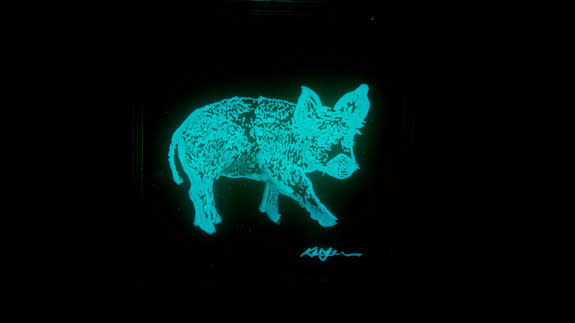Artists create living paintings from glow-in-the-dark bacteria

Artists have created glow-in-the-dark artworks from a living organism as part of the World Science Festival in Brisbane, Australia.
Instead of paint or pencils, the artists are drawing with a type of marine bacteria known as Aliivibrio fischeri, which is usually found in the light organ of the Hawaiian bobtail squid. But put it on a brush, apply it to a petri dish canvas and then turn off the lights, and you can make some sweet science art.
SEE ALSO: Twitter calls out Neil deGrasse Tyson for a dumb tweet about sex
Mashable Australia snuck into the the basement of the Queensland Museum Friday to talk to the exhibition curator, University of Auckland microbiologist Siouxsie Wiles, as she prepared for the show.

Image: Queensland museum
"This bacteria is found in a tiny little squid, about 3 centimetres long. It lives in their light organ, which is the big bulbous part underneath the squid," she said.
The squid is nocturnal and it relies on the light from the bacteria to stop itself from casting a shadow in the moonlight. "If you imagine the moon beaming down off the beautiful coast of Hawaii, the squid is in the shallow waters hunting and of course it doesn't want anything swimming underneath it — either predators or prey — to see its shadow in the moonlight. So the bacteria is casting this light down and hiding the squid's shadow." Wiles explained. "It's really clever."
Wiles was flanked by a number of local artists who were dipping their brushes in a cloudy solution that didn't seem to leave any mark on the petri dish canvases. Wiles explained the artists wouldn't have anything to show for their hard work just yet.
"Wherever the organism is placed on the jelly [of the petrie dish], overnight the bacteria will grow into a yellow bump and then when you turn the lights off, they glow in the dark."
Brisbane-based artist Sue Loveday was working on a nine panel painting of a butterfly when Mashable Australia visited. She said she doesn't usually paint with living organisms: "I've never worked with bacteria before so I jumped at the chance to do this ... It's invisible so there's a lovely randomness to it … It's back to playing with invisible ink."

Image: supplied
Wiles first started playing with bioluminescent bacteria at the University of Auckland where she researches super bugs. "I do have a very serious day job, but it also involves glow-in-the-dark bacteria," Wiles said. Her lab uses the Aliivibrio fischeri as a 'good' bacteria to assess how harmful other 'bad' bacteria are. Simply put, if the good bacteria stops glowing on contact, it means the bad bacteria has killed it.
According to Wiles, although the bacteria sounds like a lot of fun to work with, it can be volatile. "It's alive and so anything can happen," she said. "They're in control of when they turn on their light ... It should be fine, but you never know."
The Aliivibrio fischeri will live on the petrie dishes for a few days before running out of nutrients — then it's lights off for the bacteria and the art show.

